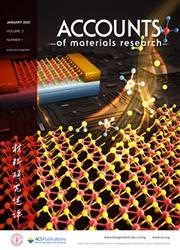[Au23(SR)16]−: A Stepping Stone towards the Rational Design of Atomically Precise Metal Nanoclusters
IF 14
Q1 CHEMISTRY, MULTIDISCIPLINARY
引用次数: 0
Abstract
Atomically precise metal nanoclusters (MNCs) have revolutionized the field of nanoscience and material chemistry with their well-defined structure, quantum confinement effect, and distinctive physicochemical properties. They have opened up new avenues for applications in diverse fields such as biomedicine, renewable energy devices, catalysis, chemical sensing, etc. These metal NCs with a size range of 1–3 nm stand out from the conventional nanoparticles (1–100 nm) due to the quantum confinement effect, which is absent in the polydisperse nanoparticles. Over the past few decades, a populous library of metal NCs with different metals, such as Au, Ag Cu, and their alloys, has been established. Of all these NCs, the molecularly pure [Au23(CHT)16]− NC (CHT = S-c-C6H11) is emerging as a potential nanomaterial with a unique structure and properties and is being used as a precursor for various transformation studies. This [Au23(CHT)16]− NC has an Au15 bipyramidal kernel, which can be viewed as an Au13 cuboctahedron capped with two hub Au atoms, protected by a pair of trimeric and monomeric staple motifs and four bridging thiolates. This unique structure of [Au23(CHT)16]− NC gives rise to interesting properties such as photoluminescence (PL) and catalysis. In this Account, we focus on the recent advances in the methods and types of different structural transformations carried out on the [Au23(CHT)16]− NC and their detailed mechanistic insights. These postsynthetic modifications have proven to be efficient strategies to induce structural changes, tune the physicochemical properties, and tailor them for promising applications. We have divided the transformation chemistry of [Au23(CHT)16]− NC into three sections. In the first section, we discuss various types of metal-exchange-induced transformation reactions carried out on the [Au23(CHT)16]− NC with different heterometal ions to achieve bimetallic NCs with various degrees of alloying and multiple alloying sites, whereas the second section deals with the various ligand-exchange-induced transformation reactions of [Au23(CHT)16]− NC, exploring the intriguing ligand effects on the NC structure and properties. Transformation reactions under other conditions, such as irradiation, oxidation, reduction, and change of solvent, are discussed in the last section. A detailed investigation into the mechanistic insights is also discussed to illustrate the driving force and other fundamentals of these transformations. Finally, we outline the future perspectives of the deep exploration of the transformation methods of [Au23(CHT)16]− NC that can advance the NC research. We hope this Account will prompt the nanoscience community to delve deeper into the fundamentals of the synthetic principles and rational design of metal NCs for broader applications.

[Au23(SR)16]-:合理设计原子精度金属纳米团簇的垫脚石
原子级精密金属纳米团簇(MNCs)以其明确的结构、量子约束效应和独特的物理化学特性,在纳米科学和材料化学领域掀起了一场革命。它们为生物医学、可再生能源设备、催化、化学传感等不同领域的应用开辟了新途径。由于多分散纳米粒子所不具有的量子束缚效应,这些尺寸范围为 1-3 纳米的金属 NC 与传统纳米粒子(1-100 纳米)相比显得与众不同。在过去的几十年里,人们已经建立了一个由不同金属(如金、银、铜及其合金)组成的金属 NC 库。在所有这些 NC 中,分子纯的 [Au23(CHT)16]-NC(CHT = S-c-C6H11)正在成为一种具有独特结构和性能的潜在纳米材料,并被用作各种转化研究的前体。这种[Au23(CHT)16]- NC 具有一个 Au15 双金字塔内核,可以看作是一个 Au13 立方八面体,顶端有两个中枢金原子,由一对三聚和单体主食图案和四个桥接硫醇保护。[Au23(CHT)16]-NC的这种独特结构产生了有趣的特性,如光致发光(PL)和催化作用。在本报告中,我们将重点介绍在[Au23(CHT)16]- NC 上进行不同结构转化的方法和类型方面的最新进展及其详细的机理见解。事实证明,这些后合成修饰是诱导结构变化、调整理化性质并使其具有良好应用前景的有效策略。我们将[Au23(CHT)16]- NC 的转化化学分为三个部分。在第一部分中,我们讨论了[Au23(CHT)16]- NC 与不同杂金属离子进行的各种金属交换诱导转化反应,以实现具有不同合金化程度和多个合金化位点的双金属 NC;第二部分则讨论了[Au23(CHT)16]- NC 的各种配体交换诱导转化反应,探讨了配体对 NC 结构和性质的有趣影响。最后一节讨论了其他条件下的转化反应,如辐照、氧化、还原和溶剂变化。此外,还讨论了对机理认识的详细研究,以说明这些转化的驱动力和其他基本原理。最后,我们概述了深入探索[Au23(CHT)16]- NC 转化方法的未来前景,这将推动 NC 研究的发展。我们希望本开户绑定手机领体验金能促使纳米科学界深入研究金属 NC 的合成原理和合理设计的基本原理,以实现更广泛的应用。
本文章由计算机程序翻译,如有差异,请以英文原文为准。
求助全文
约1分钟内获得全文
求助全文

 求助内容:
求助内容: 应助结果提醒方式:
应助结果提醒方式:


